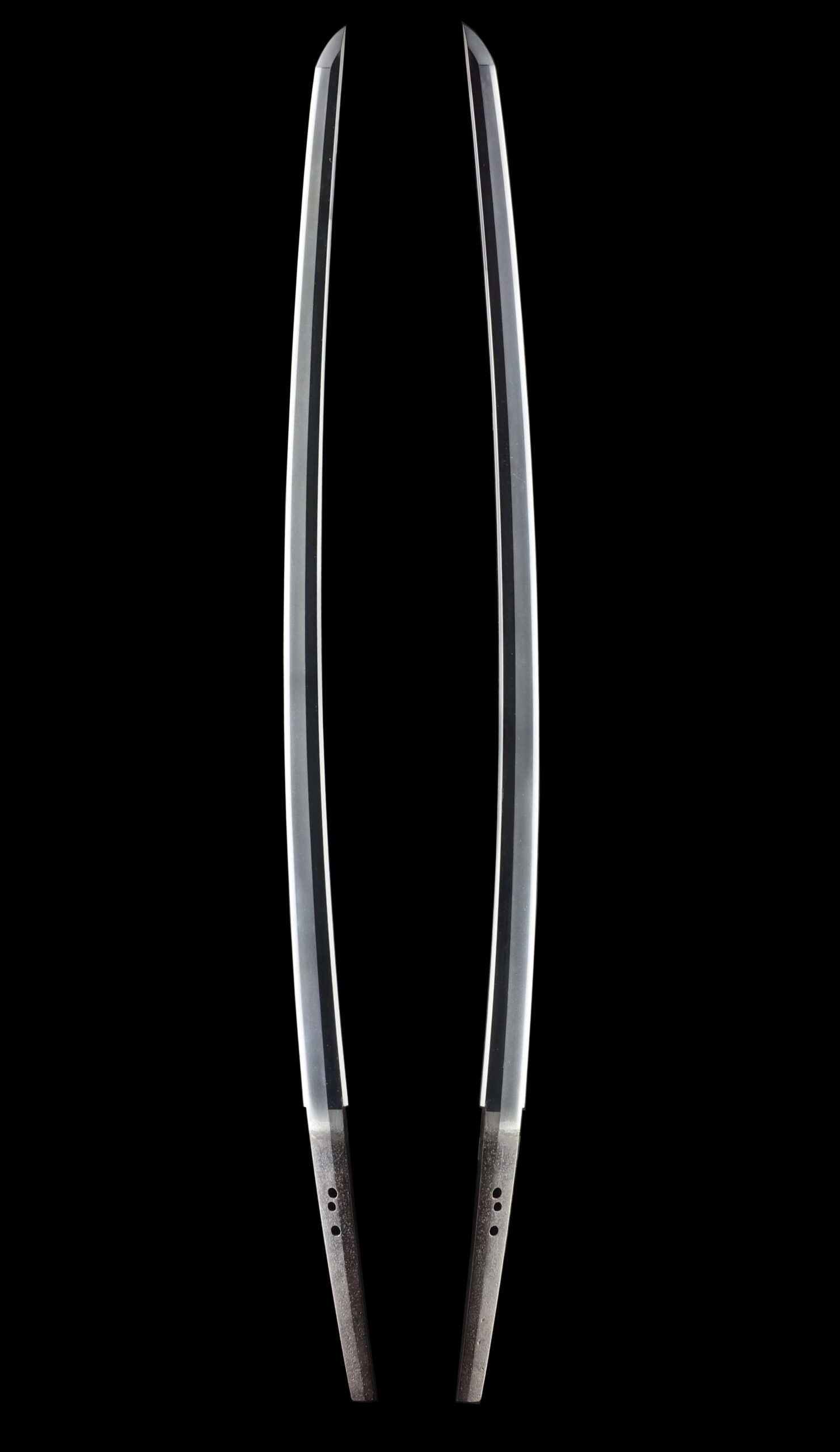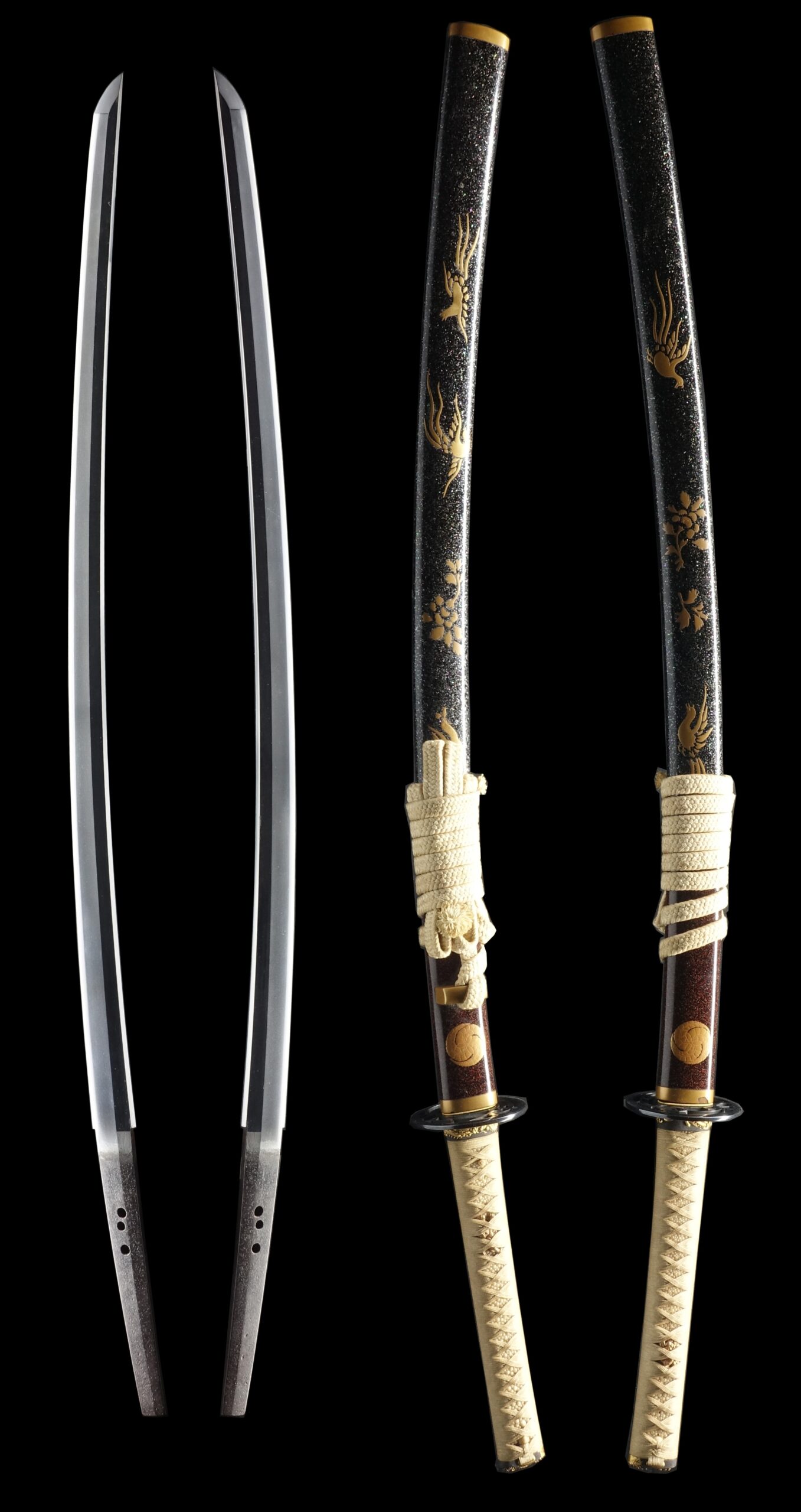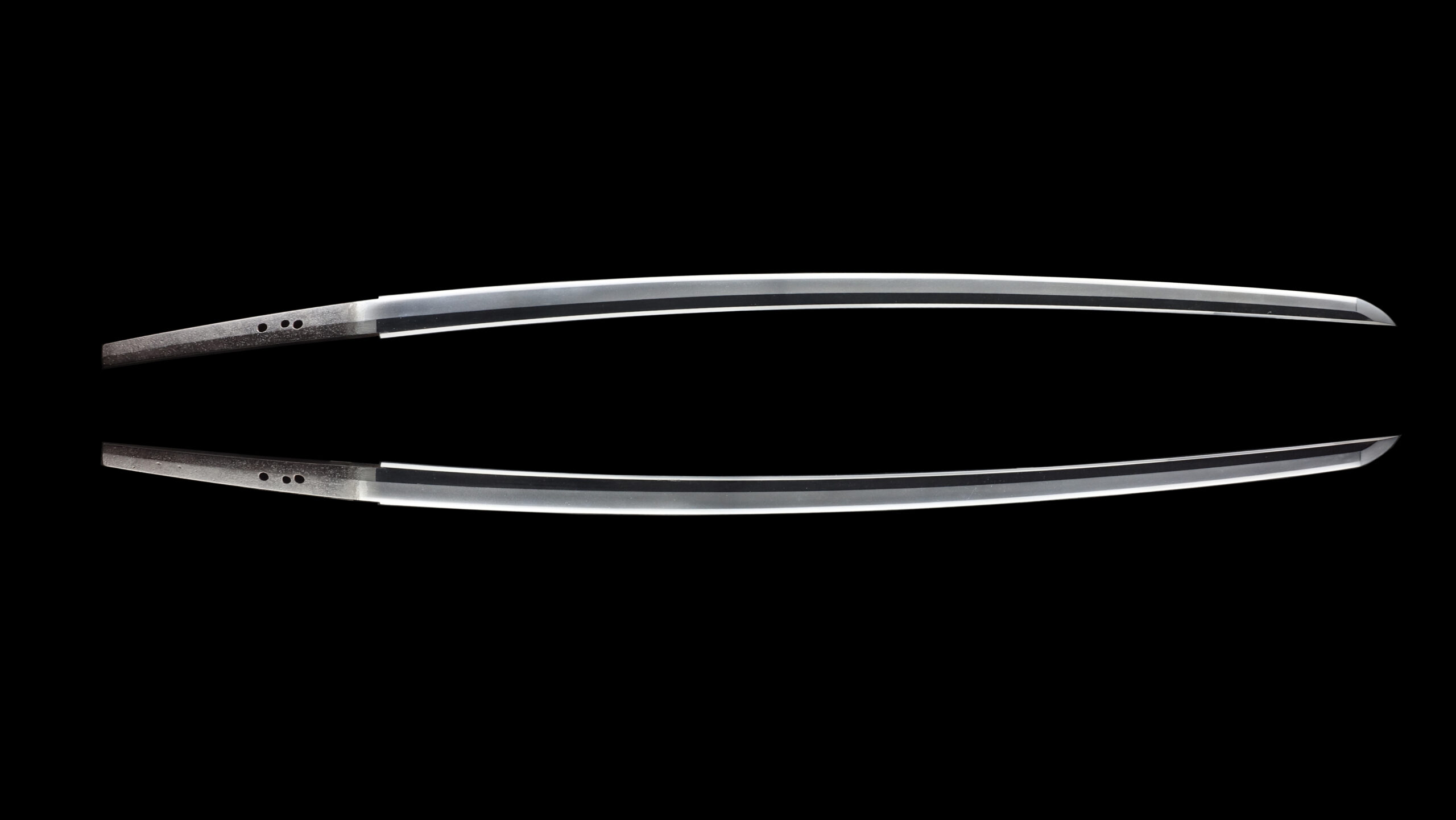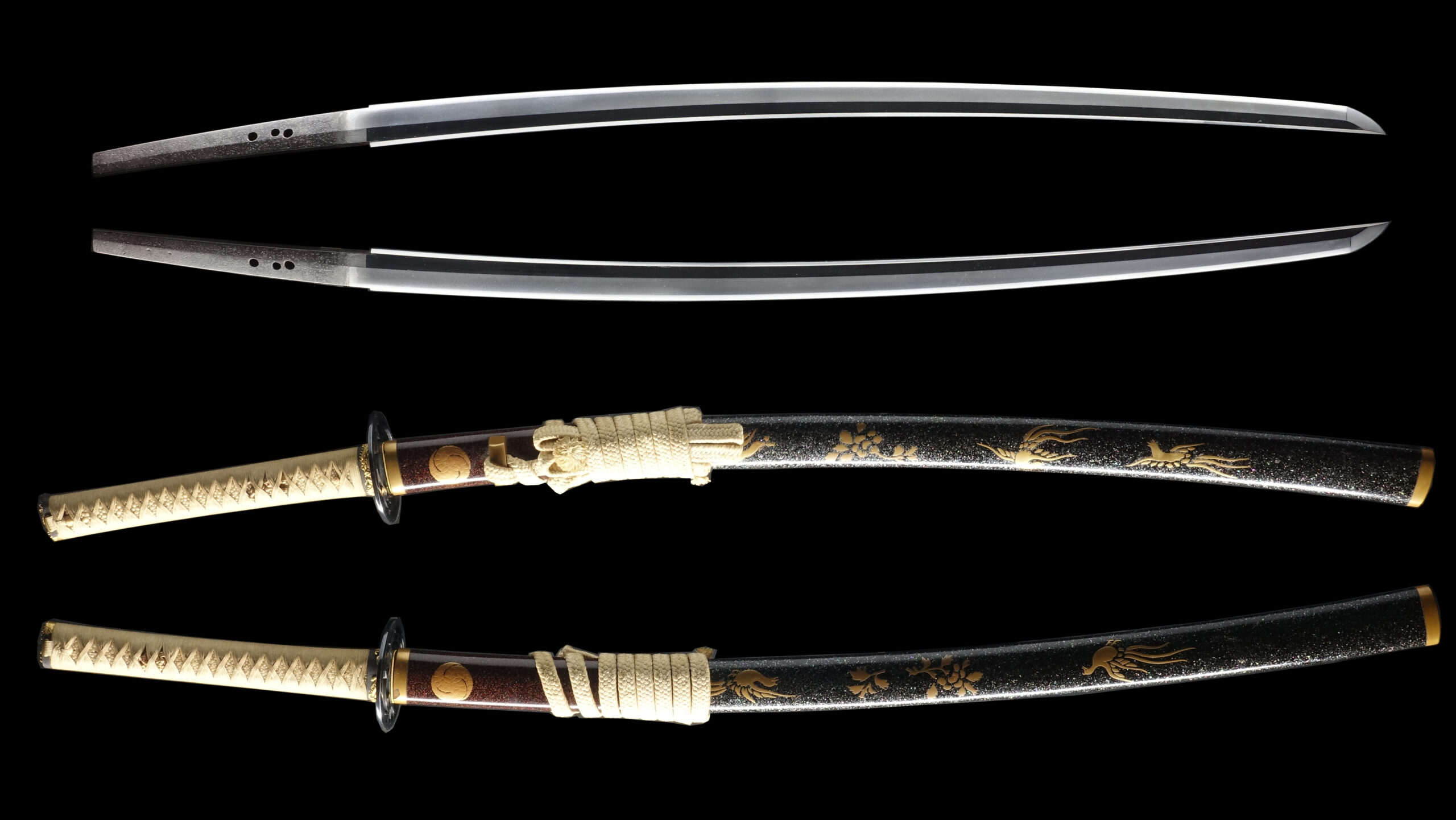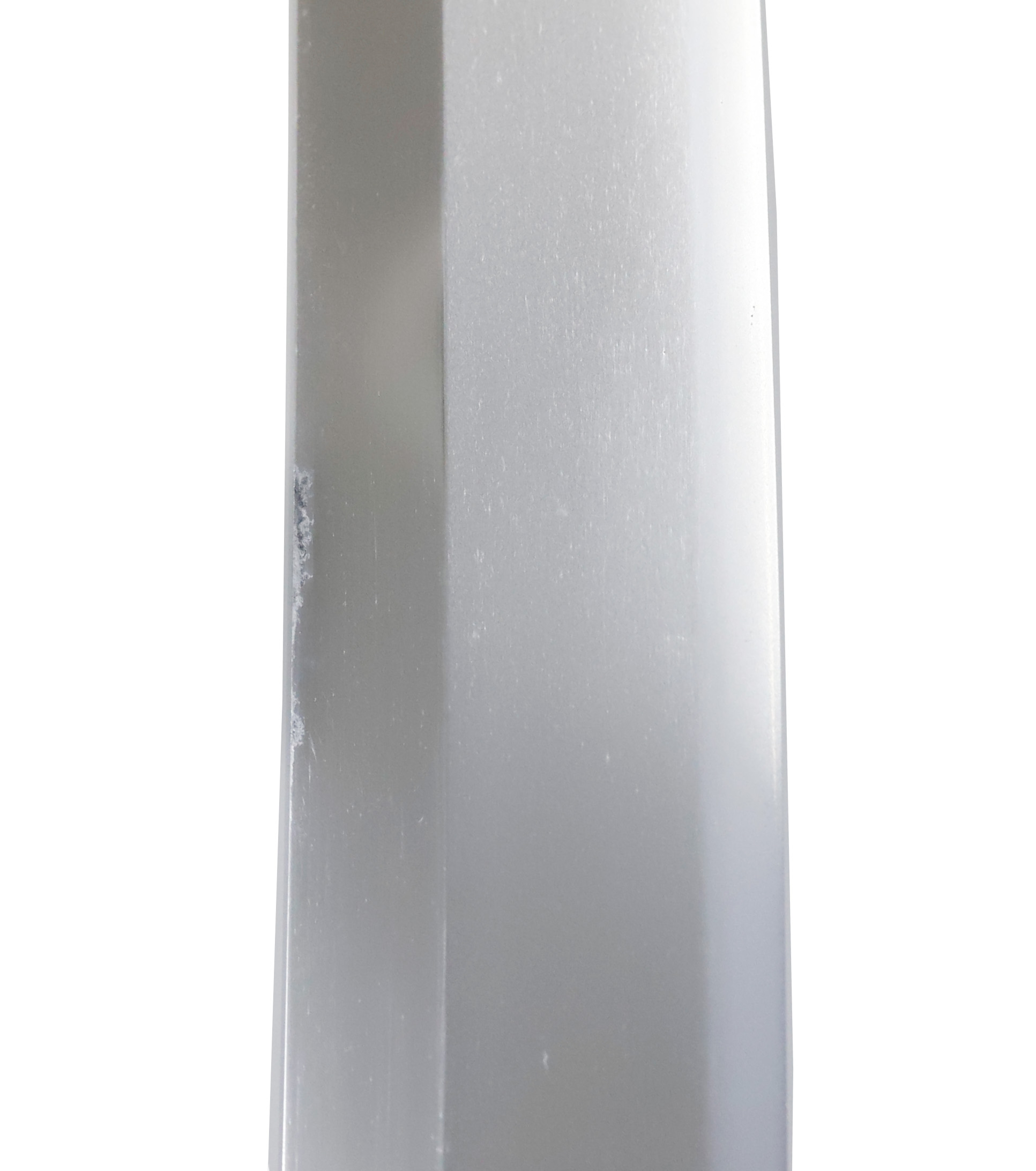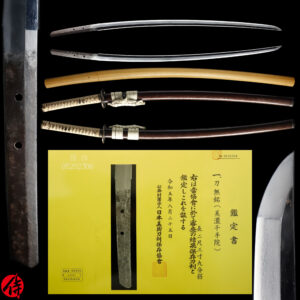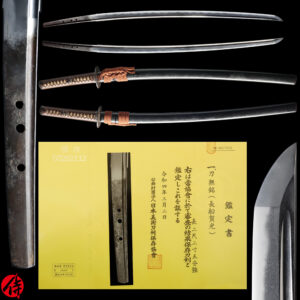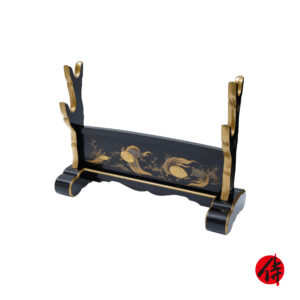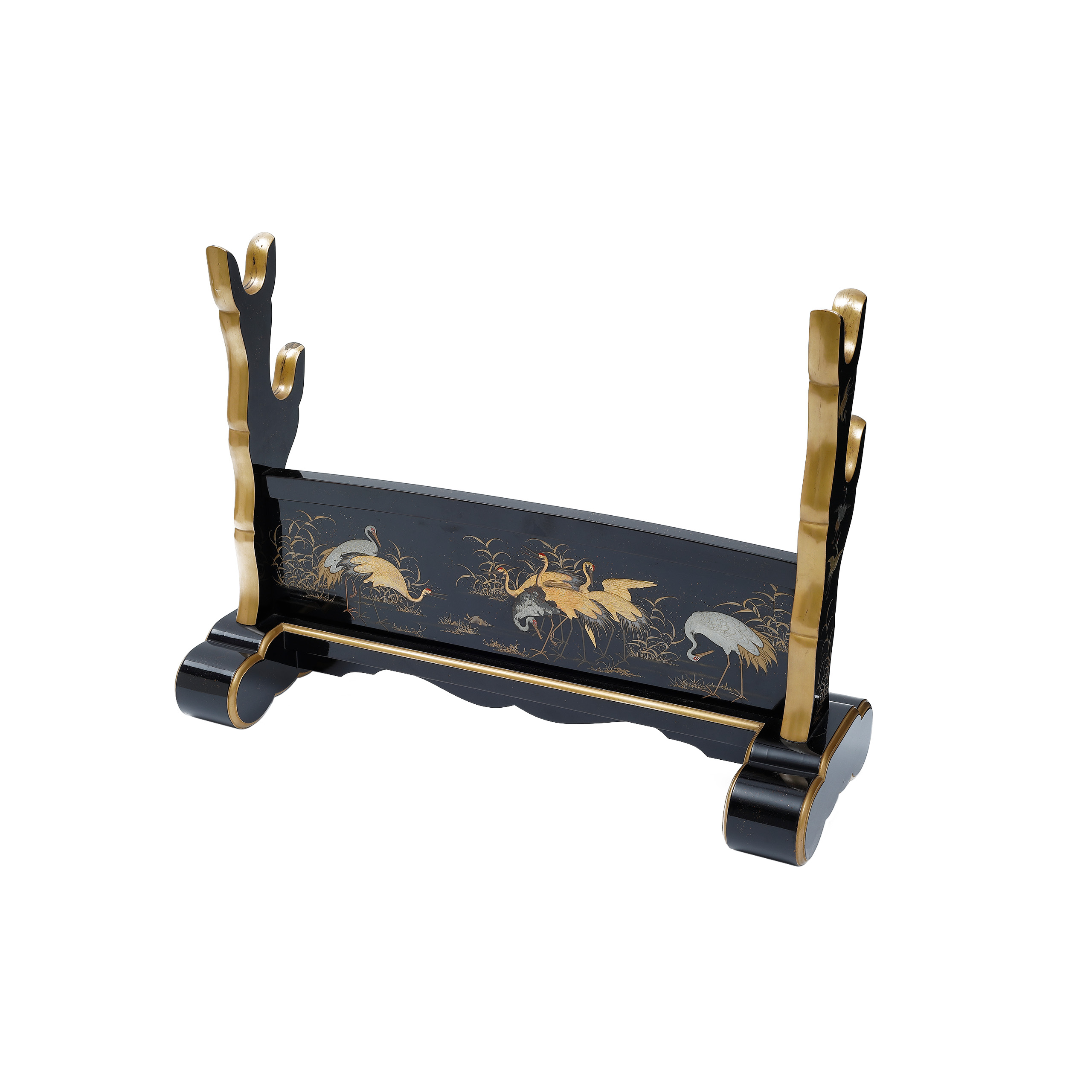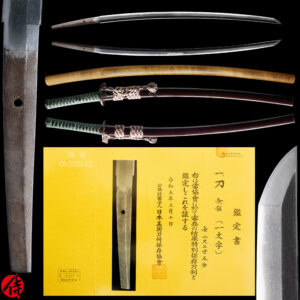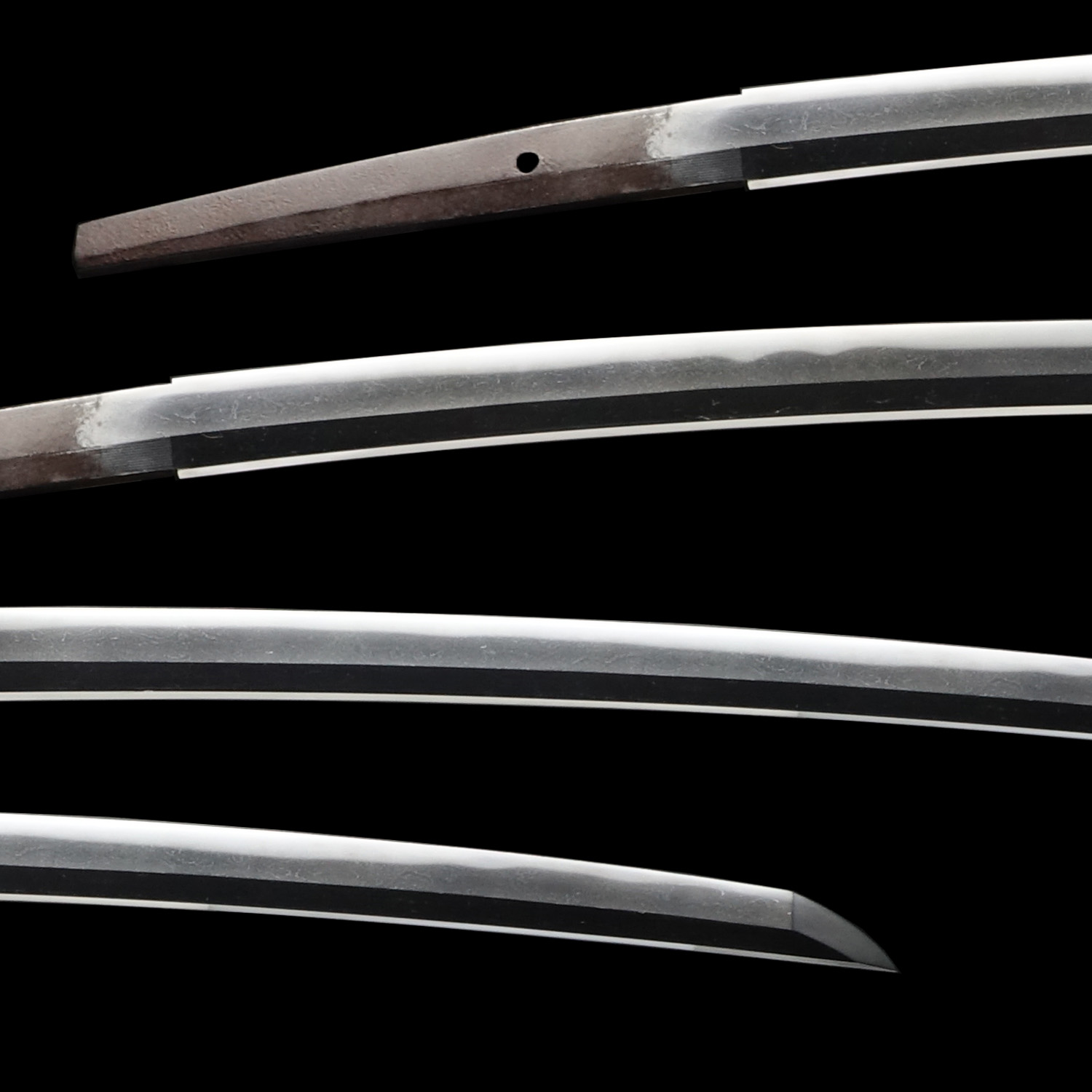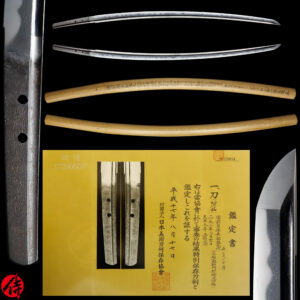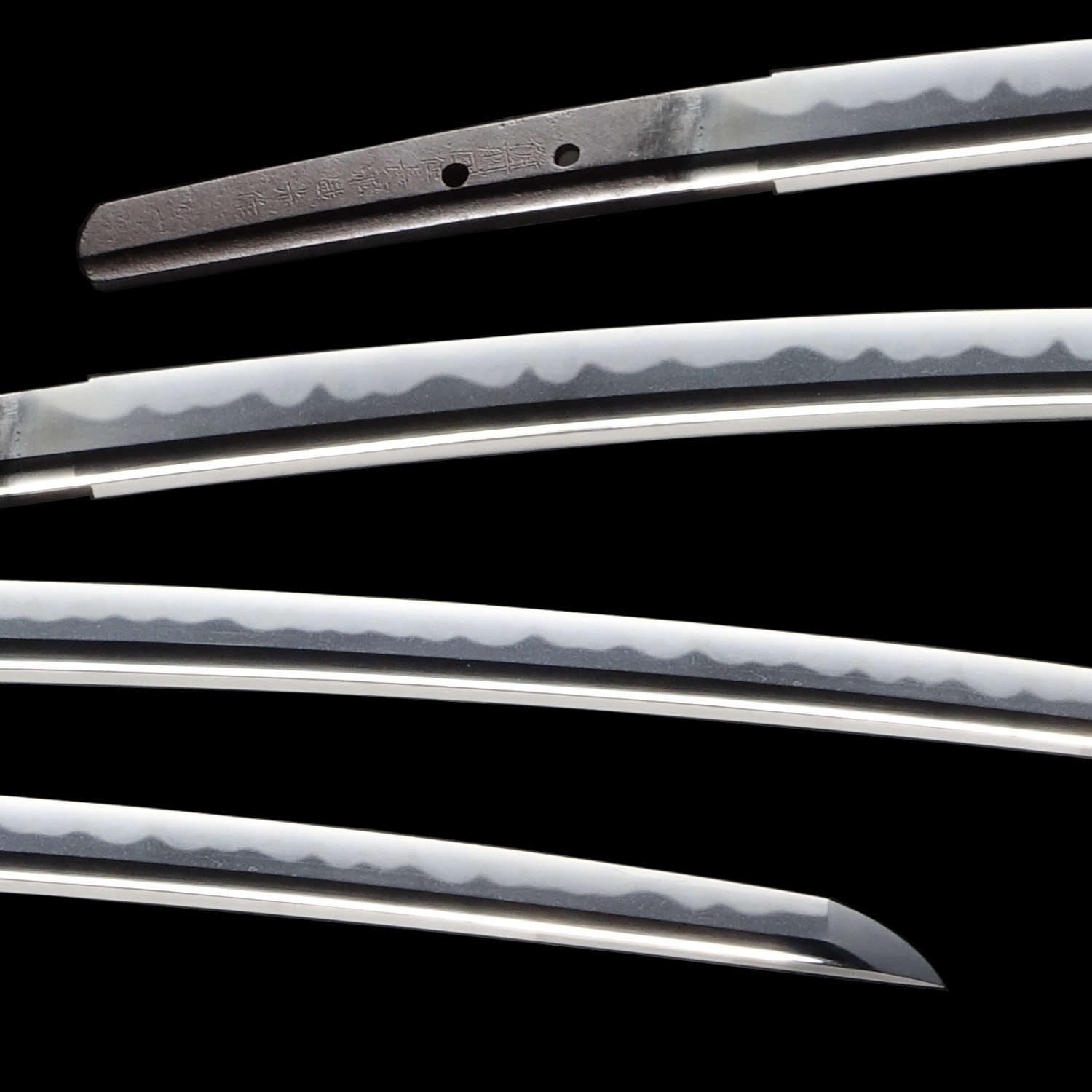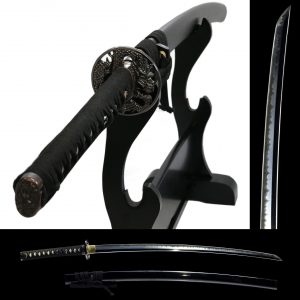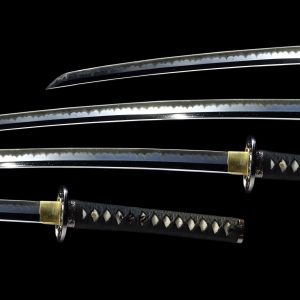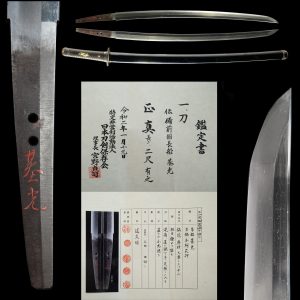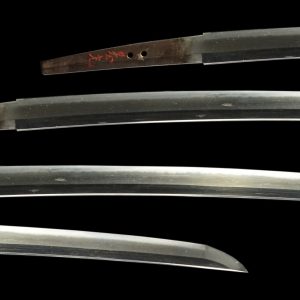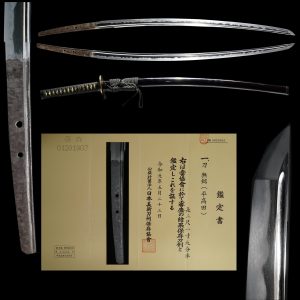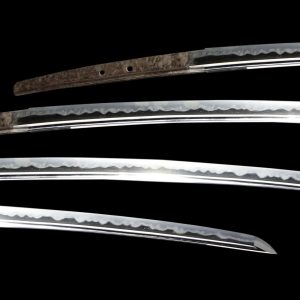Antique Japanese Sword Katana Katana Attributed to Attributed to Aoe Tsuguyoshi with NTHK Yushu Saku Certificate
【Description】
This blade is attributed to Bitchu Aoe Tsuguyoshi (備中青江次吉) in the Joji era (1362-1368: Mid Nanbokucho period), according to its NTHK appraisal. Bitchu is the province in today’s Okayama prefecture, and Aoe is the school to which Tusuguyoshi belonged. Tsuguyoshi was one of the most prominent figures in this school during the mid-Nanbokucho period.
Aoe school was founded by Yasutsugu (安次) during the late Heian period (Early 12th century), and it was located in today’s Kurashiki town, Okayama prefecture. In Bitchu province, there were two prestigious schools during that time. One is Aoe school, and the other is Seno school, established by Noritaka (則高). Aoe school was prosperous from the late Heian to the late Nanbokucho period.
Aoe school is divided into three categories in Japanese sword terminology depending on the period. When the blade is from the late Heian-mid Kamakura period, it is called *Ko-Aoe (Old Mihara). It is called Chu Mihara(Middle Aoe) for those forged in the mid Kamakura-early Nanbokucho period. Finally, Sue-Aoe (Late Aoe) is used for the late Nanbokucho period or later. Based on the NTHK appraisal of this blade, we believe it is categorized as Chu Aoe or Sue Aoe.


One of the most famous figures in Aoe school is Moritsugu, who trained Sadatsugu, Tsuguie, and Tsunetsugu. These three swordsmiths were famous for Gobankaji (御番鍛冶). Gobankaji is a unique system created by the retired emperor Go-Toba (後鳥羽上皇), who was enthusiastic about the Japanese sword-forging. He summoned twelve of the finest swordsmiths nationwide, and one swordsmith forged a blade for the emperor each month. Tsuguyoshi was the son of Tusuguie, who must have mastered superb craftsmanship.
Bitchu is located near the Chugoku Mountains, where iron sands, one of the essential materials for making Japanese swords, were abundant. Furthermore, BIZEN swordsmiths had close access to the Takahashi River, where they could find water and charcoal. This geological location contributed to the swordsmiths forging high-quality refined blades.
When Aoe school flourished in the Nanbokucho period, Japan was tumultuous because the imperial court was split into two sides(south and north). There were many conflicts, and many Samurai were deployed. The Aoe school must have dedicated itself to forging high-quality blades for those Samurai who fought in battles. It is said that they were land owners and Samurai as well. They served the southern imperial court, which ended up losing the battle against the northern imperial court. After the southern side was lost, the school’s property was ended. However, the descendants of a member of Aoe school established another school called Mizuta school in the Muromachi period, and lasted during the Edo period.
*Please keep in mind that there is one Kitae Kizu on the Shinogiji. If you like to see the detailed condition, please feel free to contact us.
【 Blade】
Cutting Edge Length(Nagasa): 69.4 cm (27.3 inches)
Curvature(Sori):1.66 cm ( 0.65 inches)

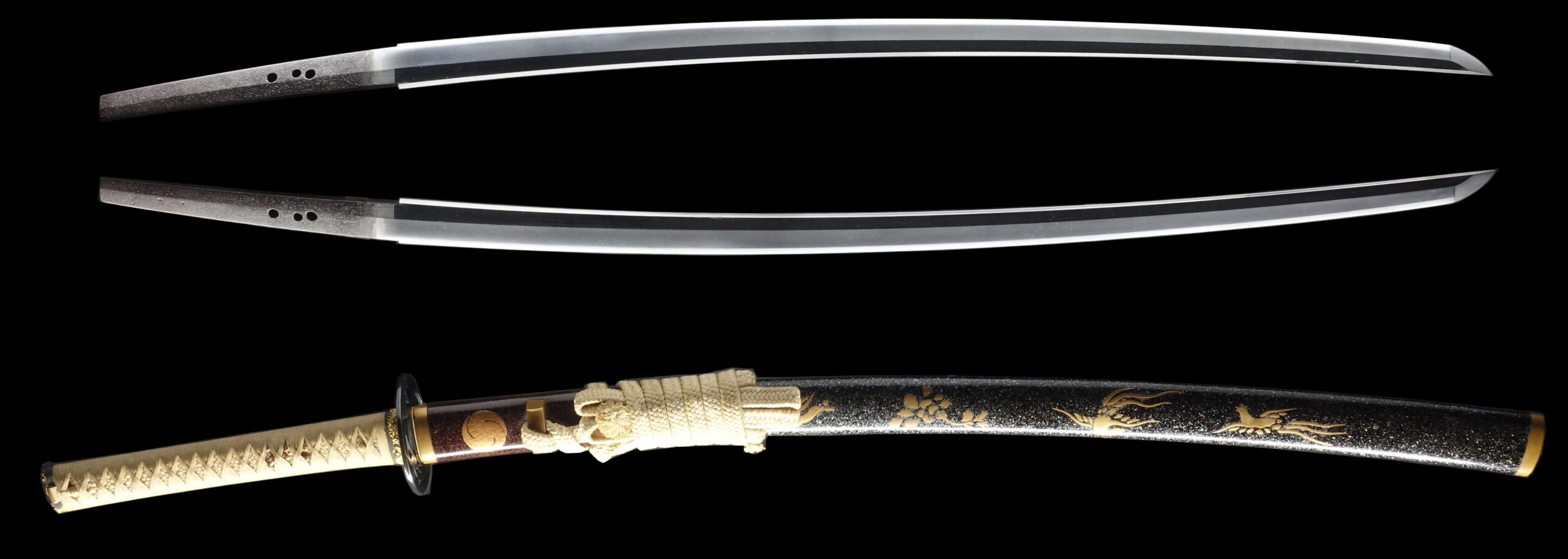
Hamon:
The crystalline structure which forms along the cutting edge of a blade as a result of the hardening process
Jimon(Jihada):
visible steel surface pattern created by folding and hammering during forging process
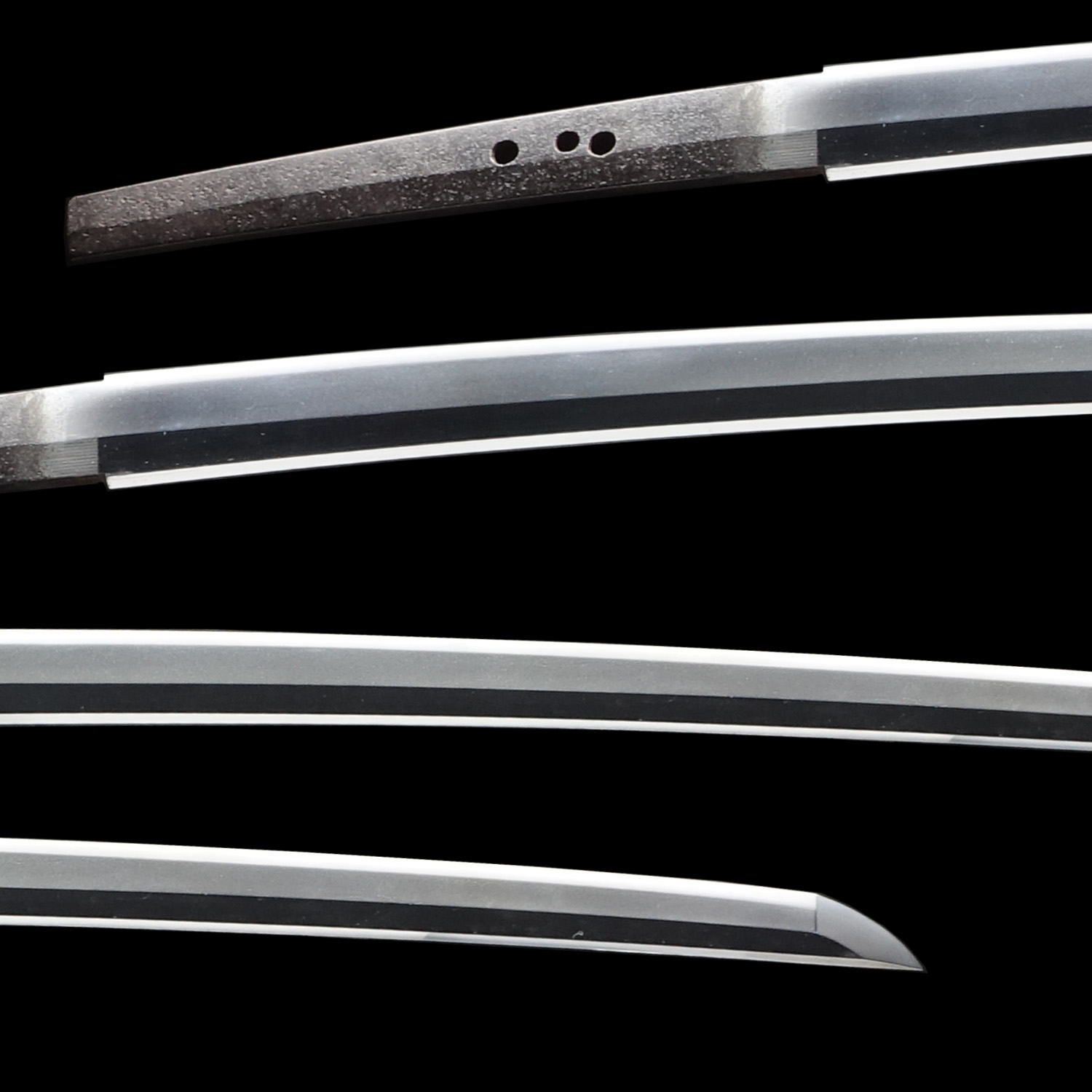
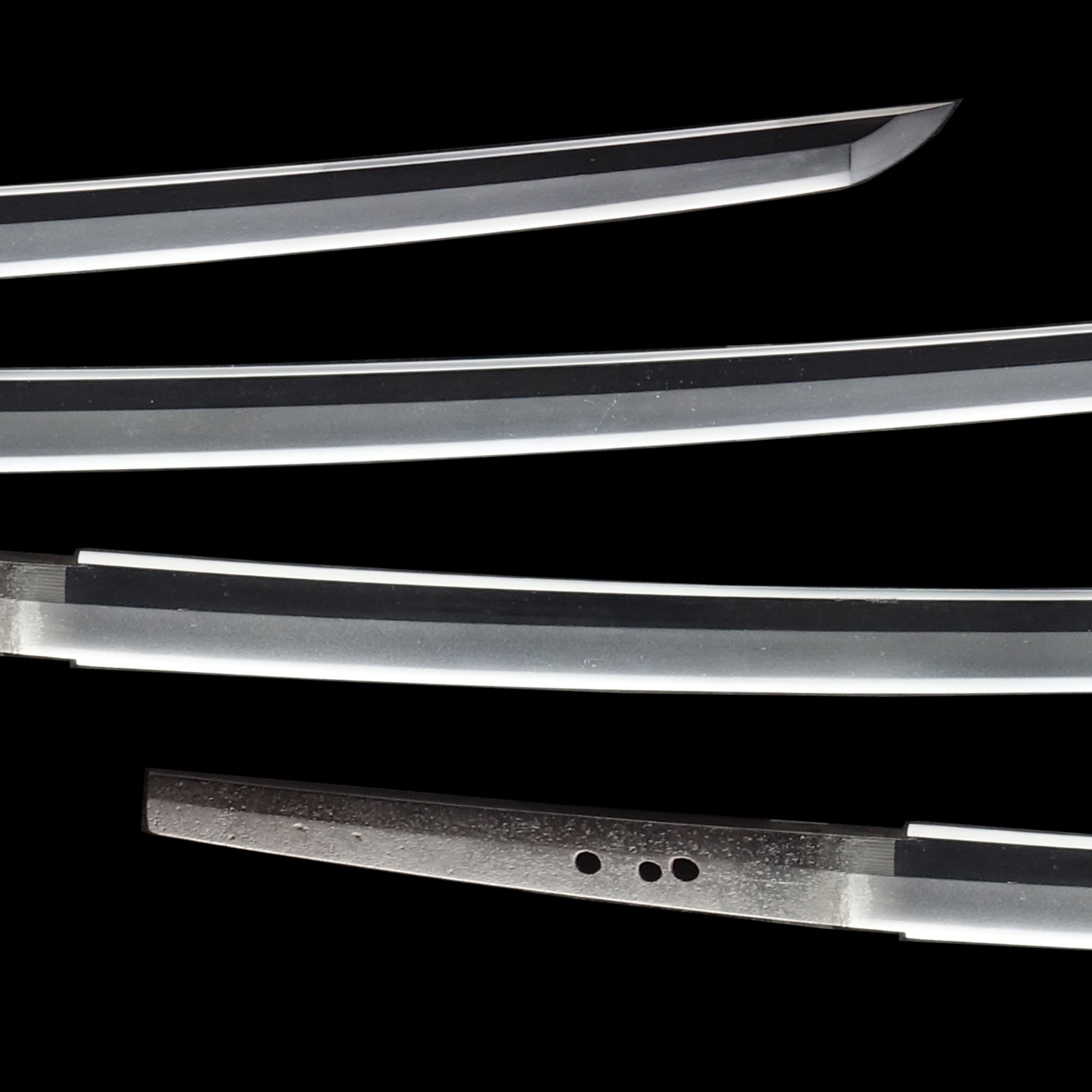
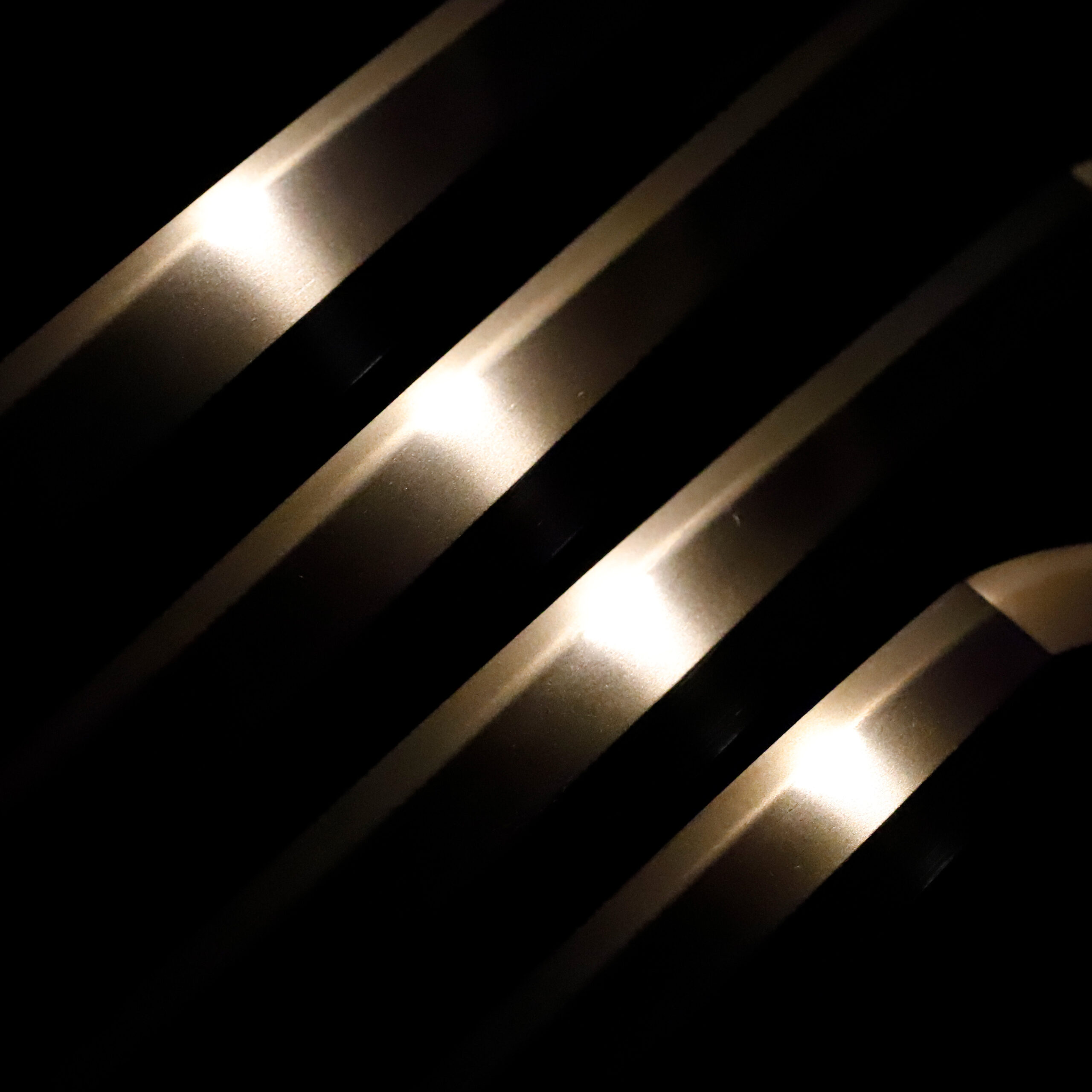
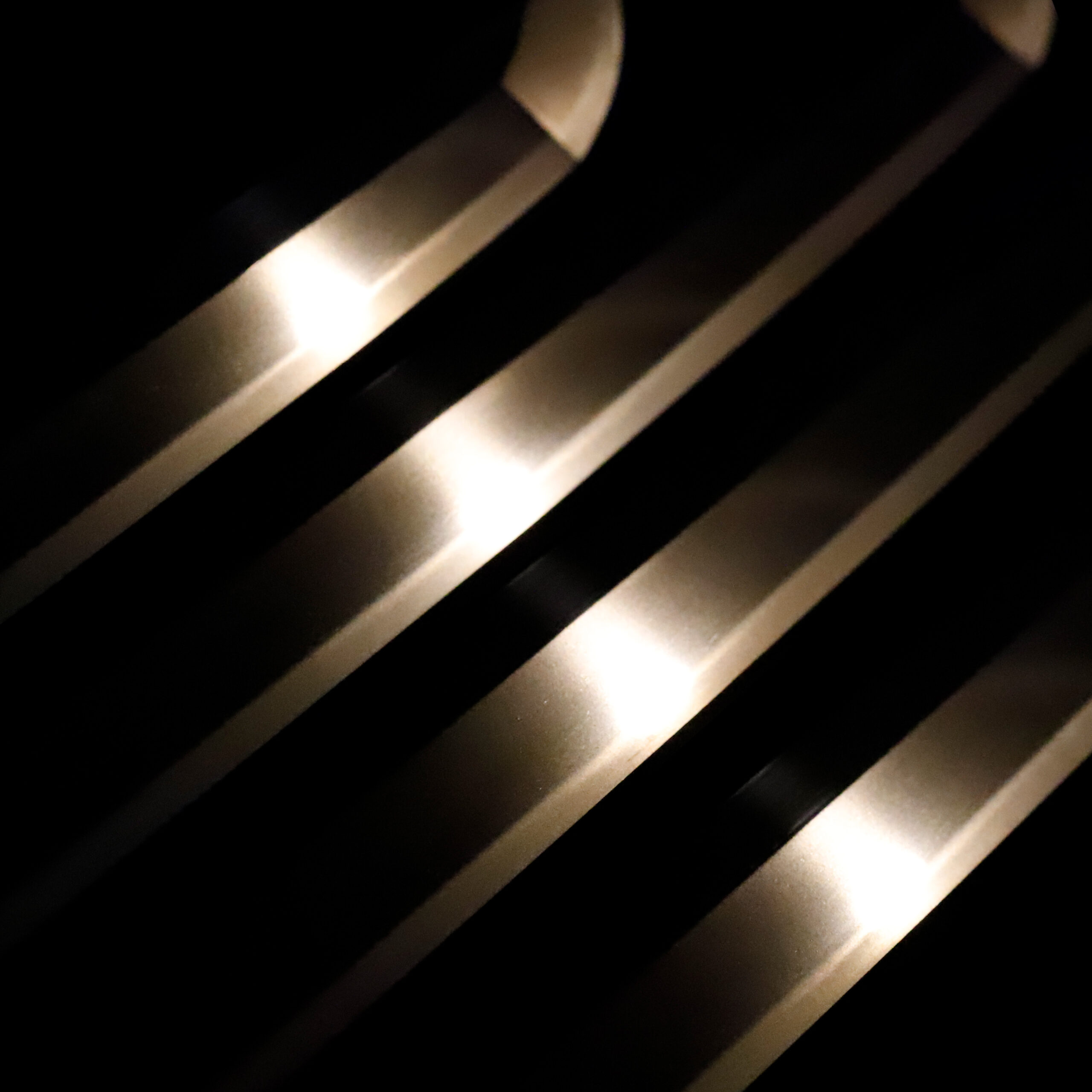
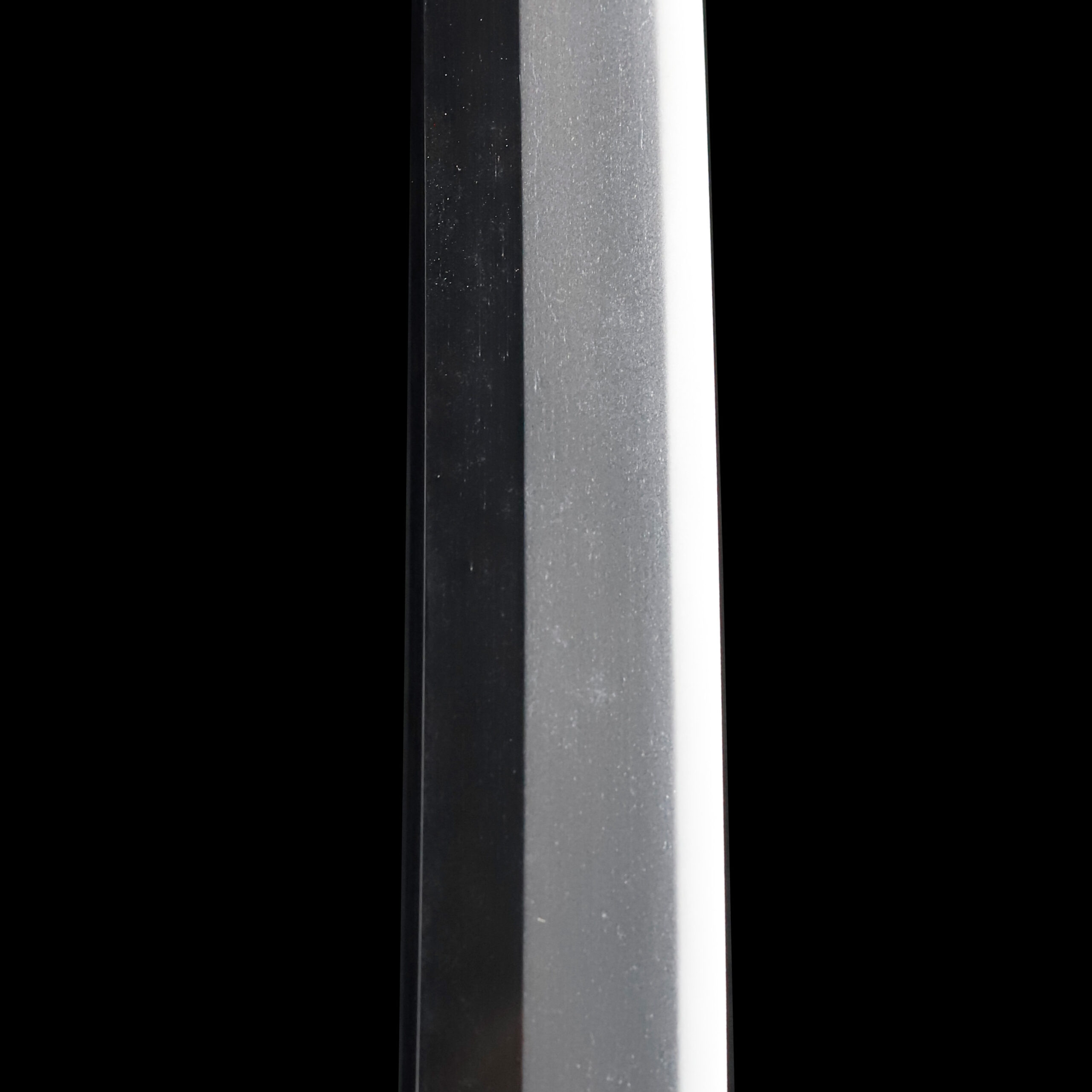
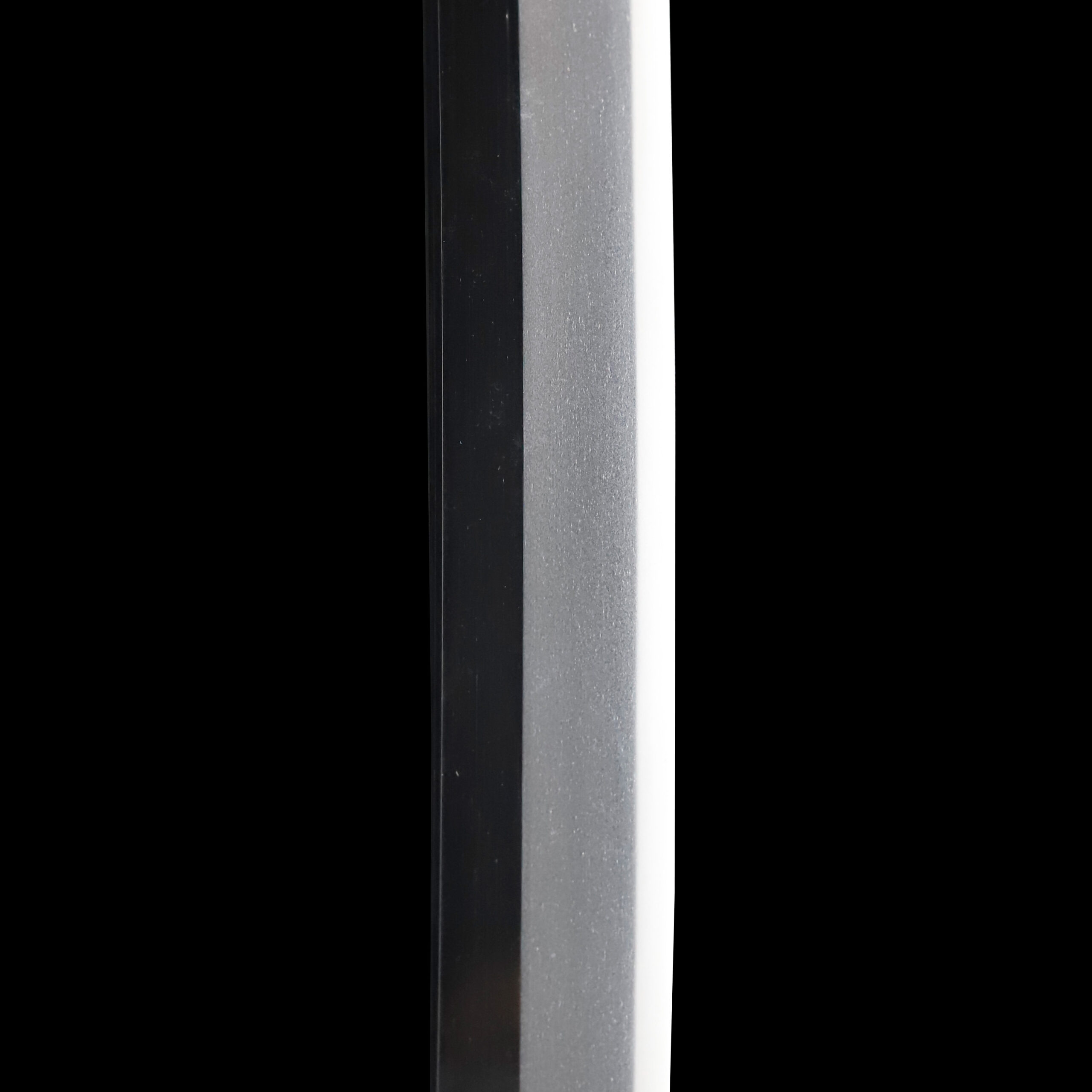
Nakago:Nakago is the tang of the Japanese sword.
Japanese swordsmiths left the black rust on the tang because it prevents red rust while the tang is in its handle. And the discoloration of the tang was created over time, and it is a great indicator for a Japanese sword specialist to estimate when the sword was forged.

Koshirae: Koshirae is the mounting of the Japanese sword. There are several parts that consist of Koshirae such as Saya(Scabbard), Tsuka(Handle), Tsuba(Handguard).
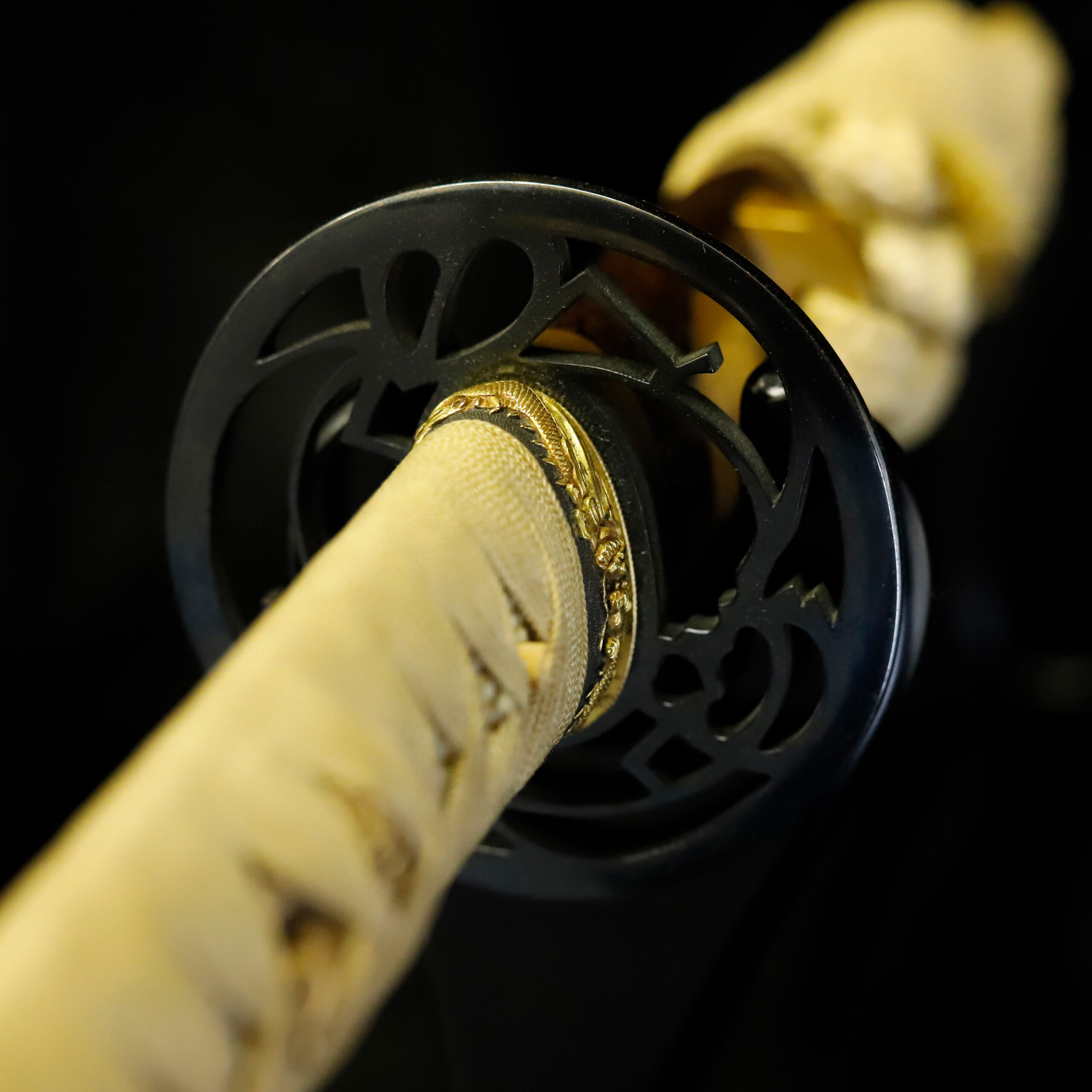
Fuchi-Kashira:A pair of matching sword fittings that cover the upper and bottom parts of its sword hilt.
The surface of this Fuchi Kashira is decorated with the Nanako-Ji (魚子地) technique. This process makes a uniform minimal protrusions pattern by hitting the Nanako-Ji Tagane (魚子地鏨, a chisel for this technique) on a metal surface. This decorative technique is often seen on sword mountings.
You would find the figure of a dragon is engraved on each Fuchi and Kashira part. Golden paint is applied to them, and its bright color adds decorativeness to this work. The dragons jump out of the water, showing off their slender, snake-like bodies, and the figures of these dragons are carefully sculpted down to the smallest detail. For example, we could see every detail of their facial expressions, toes, and scales. As mentioned above, the dragons in this work are designed in combination with water. In Japan, there is a belief that worships dragons are water gods. Since rice cultivation has flourished in this country, water is always an essential resource. Therefore, the dragon motif has been familiar to Japanese people for a long time.
Initially, dragons were imaginary creatures found in ancient foreign traditions and myths. Furthermore, it is regarded as a symbolic beast of auspicious signs. Its body is likened to nine animals: antlers are deer, the head is a camel, eyes are demons, the neck is a snake, the belly is the Mizuchi (蛟, a mythical animal in Japan that looks like a snake and has a horn and four legs), scales are fish, claws are falcons, palms are tigers, and ears are cows. It was thought that the dragon would reign at the top of all animals because of its odd-looking appearance. Based on our experiences, there are lots of dragon-design sword mountings. We believe many Samurai cherished this beast motif due to its dignified look and probably also religious view.
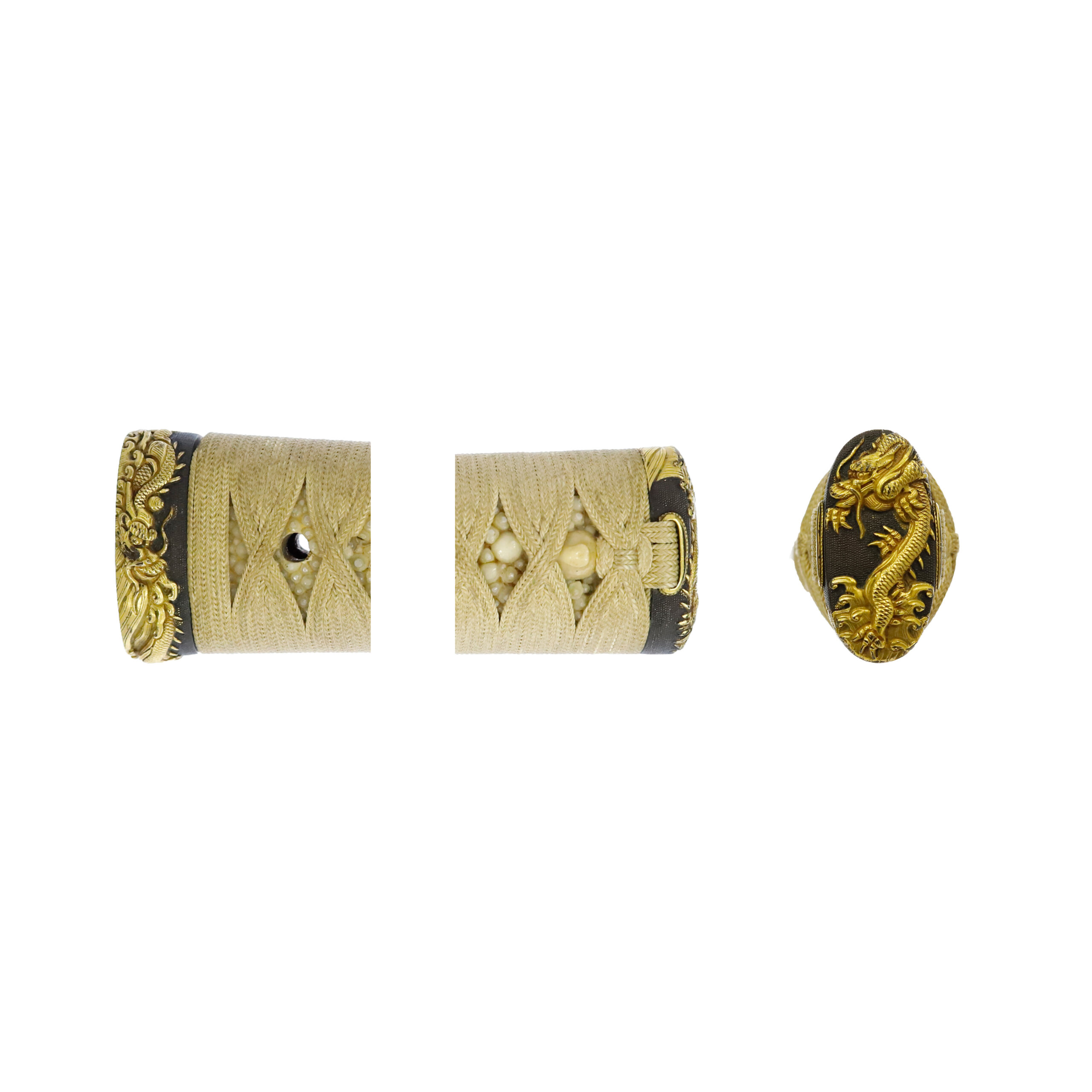
Tsuka and Menuki:Tsuka is the handle of the Japanese sword and Menuki is its decoration.
If you focus on Menuki, you will see the animal. We believe it is the Karajishi (唐獅子). The Shishi (獅子) means a lion in Japanese, and the Karajishi is a lion brought from the continent to Japan in the Toh period (唐, Tang dynasty, 618-907). The same as the Fuchi Kashira, this Menuki is also colored with shiny golden paint. It makes this work look gorgeous and enhances the elegant impression of the entire handle part.
The Karajishi typically has curly hair for its head, neck, body, and tail, as seen on this work. In Buddhism, the Karajishi is regarded as a symbol of wisdom, and Monju Bosatu (文殊菩薩, Manjushri Bodhisattva) rides lions. According to a theory, the Karajishi is the origin of Komainu (狛犬, stone guardian dogs that exorcize evil spirits). It shows this animal motif has been familiar to Japanese people since ancient times. Dragons and Karajishis, this handle part is decorated with such auspicious beast motifs.

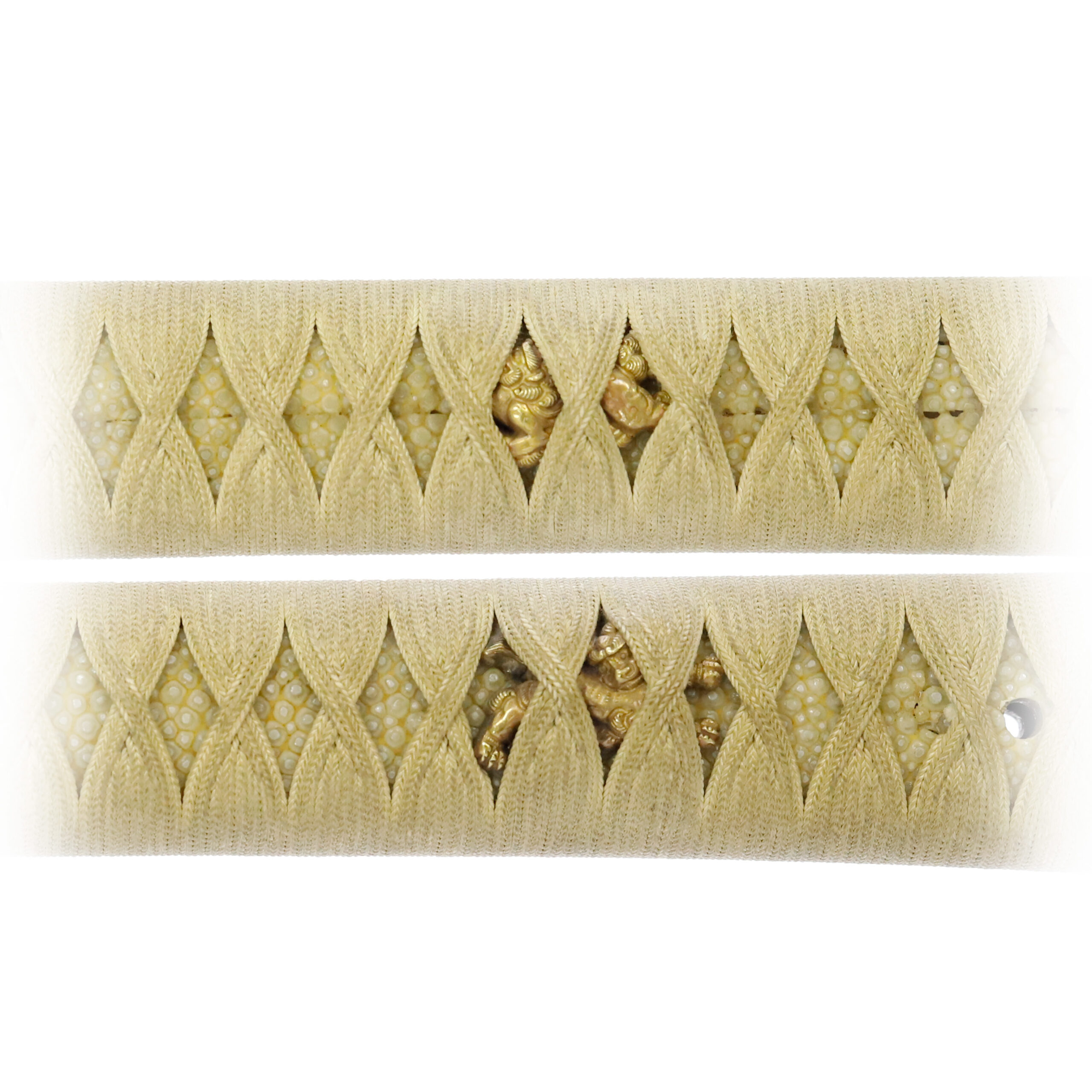
Tsuba and Habaki:Tsuba is the handguard for the Japanese Sword and Habaki is the equipment to make the blade not touch its scabbard inside. It prevents the blade from getting rusty and chipped.
About the design, we estimate some insects are engraved on this Tsuba. It seems we could find the figure of three insects depicted with an abstract design. Despite no gold or silver decorations, this Tsuba has an attractive beauty of black metal material. We are still determining what type of insects are designed here. We assume they are crickets, dung beetles, or something else. However, we would say that we often find sword mountings with insect patterns. For example, butterflies and dragonflies were cherished by many samurai as lucky charms. Since butterflies change their looks from larvas to chrysalis, it symbolizes being reborn; therefore, the same as the dragonfly, Samurai loved this design. Dragonflies bag preys quickly; their heroic figures were sometimes the object of belief. During the Warring States period, a dragonfly was called the Kachimushi (勝ち虫, winning insect) because of its fearless character; it moves only forward, not backward. In this way, Japanese people have favored some insect designs for a long time. This Tsuba is one of those items that shows such popularity.
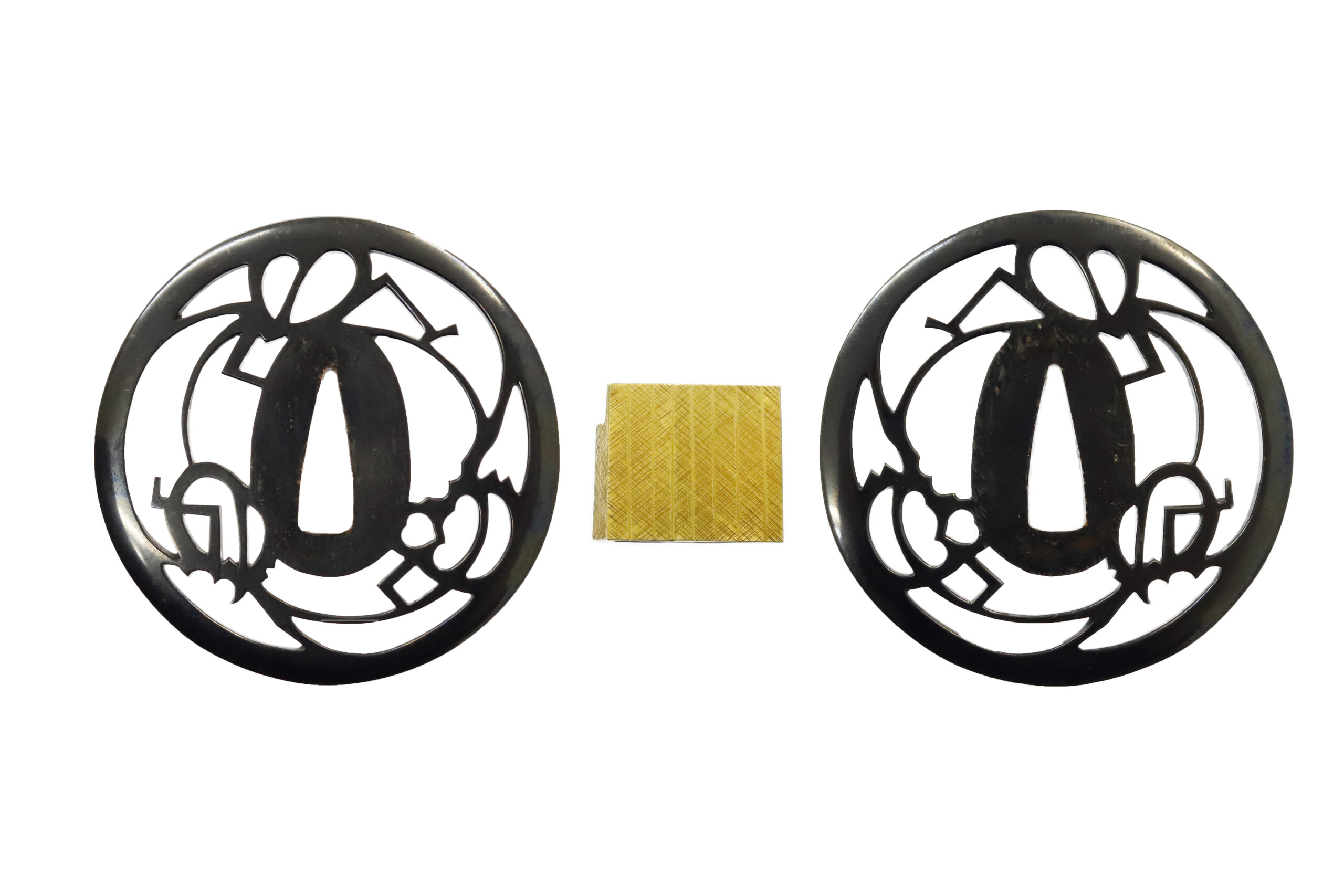
Saya: Saya is the scabbard for the Japanese sword.
There is a chipping on this scabbard, it is at the Koikuchi (鯉口) part. Please check the attached photo.
About the design, you would find the family crests are designed on it. This crest is called the Jikutsuki Migi Mitsu Fuji Domoe Mon (軸付き右三つ藤巴紋). It is a type of the Fuji (藤, Japanese wisteria) pattern. In addition, a bird figure is also depicted on this scabbard. We would like to propose two possibilities for its model: the Suzaku (朱雀) or the Houou (鳳凰, Fenguang). Suzaku is a member of Shijin (四神, four gods) with Seiryu (青龍), Byakko (白虎), and Genbu (玄武). These spiritual beasts protect the four directions: east, west, south, and north. Houou is a member of four fantasy animals, which is called “Shirei (四霊)” with Kirin (麒麟, Qilin), Kame (亀, Turtle), and Ryu (龍, Dragon), and it is a god beast looks like a combination of chicken and peacock. Houou was considered an auspicious sign in ancient China, and it was believed that Houou would show up when the brilliant emperor appeared. People appreciate its graceful shape in Japan.

Authentication Paper:NTHK Yushu Saku Certificate for the blade
NTHK, also known as NPO Nihon Touken Hozon Kai, is the oldest organization for sword authentication of Japanese swords in modern times. It was established in 1889 during the post-Samurai era. They authenticated the blade on Dec 12th in the 3rd year of Reiwa (2021) as Yushu To, which is the highest appraisal in NTHK. The purchaser will receive this original certificate as well. We can also translate what is written into English and make a PDF file for your record if you request.
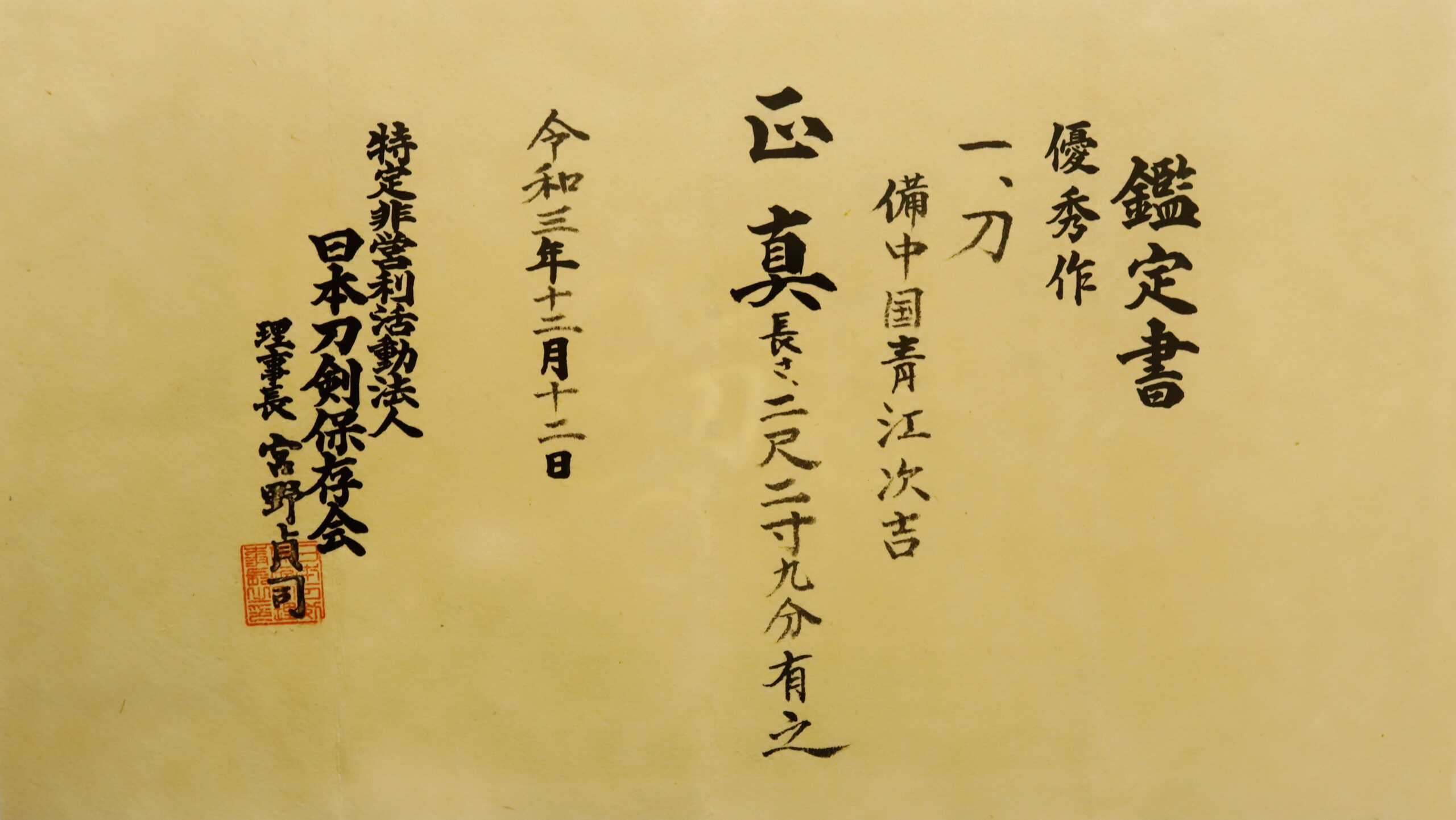

Registration Number : Kanagawa 3467
The Board of Education in Kanagawa prefecture issued a registration paper for this sword . It is called Jyu Token Rui Torokusho(銃刀剣類登録証). Bunkacho(The Agency for Cultural Affairs) acknowledges a Japanese sword with this paper as a work of art.
The sword needs to be traditionally hand-forged and made of Tamahagane carbon steel to be registered in the system. With this paper, its owner in Japan can legally own an authentic Japanese sword. Based on this registration number, we will apply for its export permit.
This paper will need to be returned to the board of education when the sword is being shipped abroad, but you can receive a copy of it. An English translation of this registration paper is available on request.

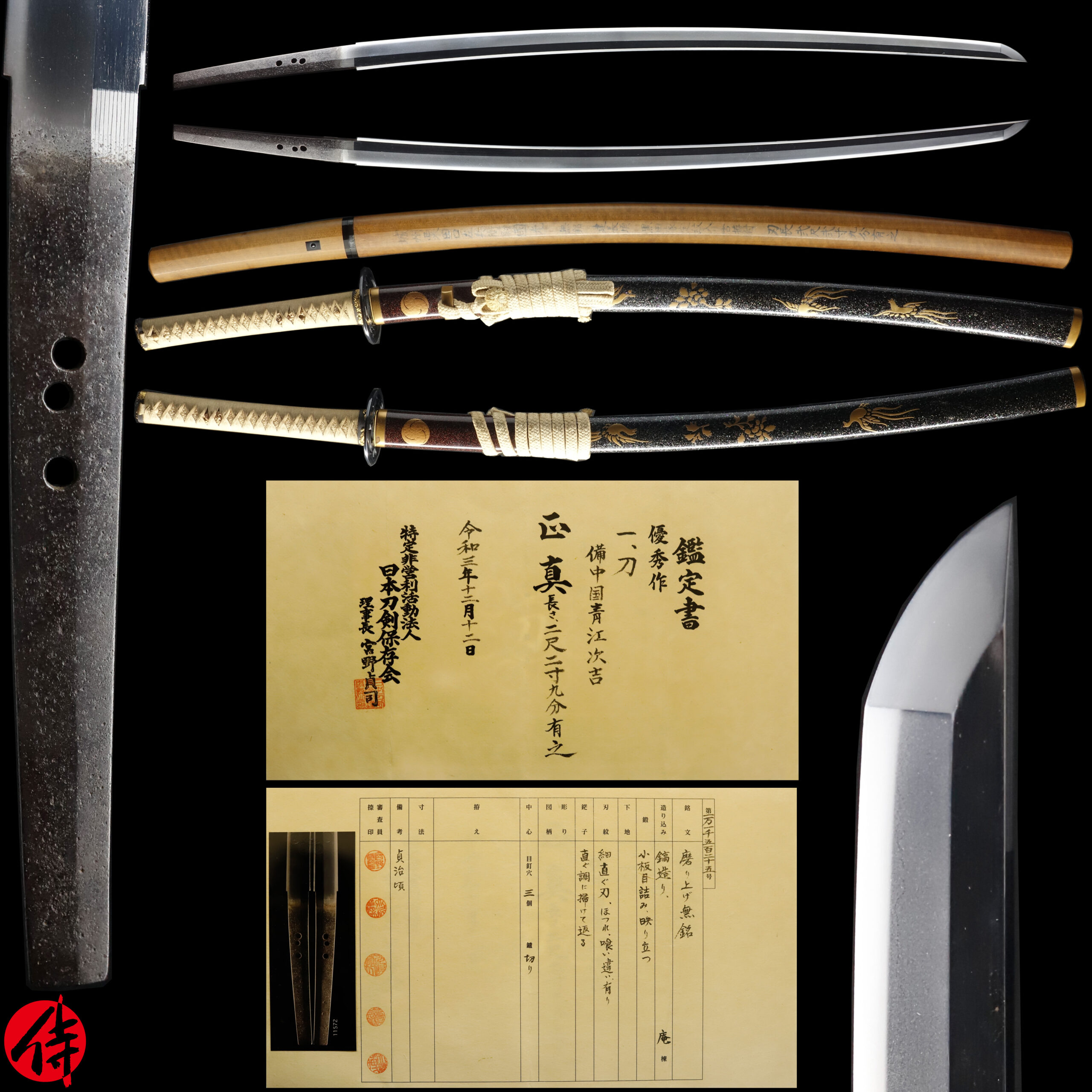
—————————————————————–
【About us】
Samurai Museum is located in Tokyo, Japan, exhibiting antique artifacts related to the Samurai history. Samurai Museum Shop is the place for those who are interested in Japanese culture and craftsmanship. We deal with antique Samurai swords/armor, traditional crafts made in Japan and so on.
【Japanese Sword& Export Process】
The Japanese swords we deal with are hand-forged edged swords made in Japan. It was made from the traditional carbon steel called TAMAHAGANE(玉鋼). Samurai Museum is familiar with the proper legal procedure for an antique/ authentic Japanese sword to be exported from Japan. We have sent more than 500 Japanese swords for the past few years (~2024) to amazing owners who appreciate its historical value.
Each Japanese sword is registered under the Agency for Cultural Affairs and the Board of Education in Japan. They issue a registration paper for each Japanese sword for its owner in Japan to legally possess it. The Japanese sword with its registration paper means it was traditionally hand-forged in Japan.
To legally export the sword from Japan to other countries, we will have to apply for its permit to the Agency for Cultural Affairs(Bunkacho) and return the original registration paper to the Board of Education. It normally takes around 2-4 weeks to receive this permit after submitting required documents. And we would like you to expect at least 1-1.5 months for your order to arrive at your given address after you ordered. For more detailed info, please click here.
It is allowed for residents in Japan to own authentic Japanese swords without a special license as long as they come with registration papers. Please feel free to contact us if you are a resident of Japan, whether temporarily or permanently. We will also assist you when you leave Japan and need to obtain the export permit.
【Payment Method】
We accept payment through Stripe (Credit card), PayPal, Apple Pay or ChromePay, all of which are secure payment methods. Also, you don’t need to make an account on Stripe for the checkout. If you prefer other payment method, please contact us. After confirming your payment, we will apply for an export permit. You may either pay in JPY, USD, AUD, CAD,EUR CHF or GBP. The price is set in Japanese Yen. Prices in other currencies are automatically calculated based on the latest exchange rate.

* If the amount is above 1 million JPY, Stripe or wire transfer will be the only options for payment.
【Shipping】
We have shipped authentic Japanese swords to the USA, UK, Canada, Mexico, Germany, France, Hong Kong, Finland and Australia. If you don’t live in these countries and like to order, please contact us first before making a purchase. We offer Free International Shipping as long as we can send antique Japanese swords by EMS.
We normally ship by EMS(Express Mail Service) provided by Japan Post. We will send you a tracking number for your order as soon as we hand it to the post office. We will put 100 % insurance on the shipping document without any extra charge. Based on the total amount, there might be a duty tax or other fee for you to pay, depending on the countries. We use package cushioning to protect the item and put it in a PVC pipe, which is one of the most secure packages because of its durability.
It will normally takes 5-14 days for the item to arrive at your given address after we dispatch it. Time of delivery is estimated as accurately as possible by the carrier but does not take into account any delays beyond our control such as by inclement weather, post office holiday seasons.
* If you live in Australia and like to purchase an authentic Japanese sword, please click here to know the detail.

【Review】
Here is one of the reviews we received from a customer who purchased an authentic Japanese sword from us. For more reviews, please click here.
“My experience overall with the whole process was wonderful. I had many questions about the history and process to purchase these treasures. All my questions were answered very timely and complete. The staff is very knowledgeable and very well versed if any questions do arise.”
【How to make sure the condition】
Please keep in mind that what you are going to purchase is an antique item. We uploaded high resolution photos for you to check its condition thoroughly. If you like to see more photos with different angles, please feel free to contact us. We will be happy to send them to you so that you can make informed decision. It is essential for us to know that you are happy with your choice of a sword. and we are prepared to use the best of our ability to serve you.
【How To Contact Us】
Please contact us through email, Facebook Messenger or Live Chat if you have any questions. You can find each icon on the right side of the website. Please click one of them to reach us. We will reply to you within 1-2 business days.
【The Art of Nihonto (Japanese Sword)】
Samurai’s history is a profound, eloquent legacy of ancient Japanese warriors in which millions of people worldwide are being fascinated. If you like to find out the art of Nihonto, please click here.
【A Guide to Japanese Sword Maintenance】
After acquiring an genuine Japanese sword, it is also important to know how to take good care of it. Here is the special video for you. Mr. Paul Martin, Japanese sword expert, shows you how to give proper maintenance to your sword. By mastering how to clean the Japanese sword, its aesthetic beauty will last forever.
When you purchase a Japanese sword from us, you can get a Free Japanese sword maintenance kit. It comes with four tools(Choji Oil, Uchiko Whetstone Powder, Peg remover, Oil Applicator). By watching the video instruction above , you can enjoy learning how to maintain your Japanese sword while appreciating it. If you have any difficulty assembling the sword or cleaning the blade, you can feel free to contact us.


MORE ANTIQUE JAPANESE SWORD FOR SALE
SWORDS WITHOUT CERTIFICATES FOR SALE
LEARN JAPANESE SWORD TERMINOLOGY
Thank you for reading all the information on the page. If you have any difficulty choosing the right Japanese sword for you, we will be more than happy to help you find the one that speaks to you the most. Please feel free to contact us.
